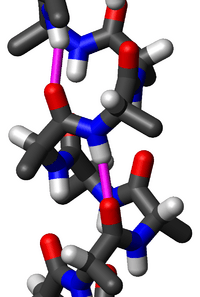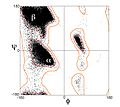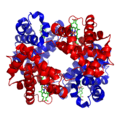Alpha helix facts for kids
.
An alpha helix (α-helix) is a twisted part of a protein. It is one of the two most common parts of the secondary structure, or shape, of a protein. The other is the beta sheet. An alpha helix is created by alternating groups of atoms. There is a carbonyl group, created by a carbon atom double bonded to an oxygen atom, and an amine group, created by a nitrogen atom bonded to a hydrogen atom. Each section containing one of each of these groups is called a residue, a general term for a small part of a molecule. Each amine group forms a hydrogen bond with the carbonyl group four residues earlier. A prion is a protein that causes disease by changing the shape of another protein. It does this by changing some of the alpha helices, which are more common in normal cells, to beta sheets, which are more common in prions. The alpha helix consists of 3.6 residues per turn. All hydrogen bonds face in the same direction. If two or more alpha helices come together, they become a tertiary structure. (Ex. Five alpha helices arranged into a barrel shape)
Images for kids
-
The Hemoglobin molecule has four heme-binding subunits, each made largely of α-helices.
-
Leucine zipper coiled-coil helices & DNA-binding helices: transcription factor Max (PDB file 1HLO)
-
Bovine rhodopsin (PDB file 1GZM), with a bundle of seven helices crossing the membrane (membrane surfaces marked by horizontal lines)
-
Julian Voss-Andreae's Alpha Helix for Linus Pauling (2004), powder coated steel, height 10 ft (3 m). The sculpture stands in front of Pauling's childhood home on 3945 SE Hawthorne Boulevard in Portland, Oregon, USA.
See also
 In Spanish: Hélice alfa para niños
In Spanish: Hélice alfa para niños










